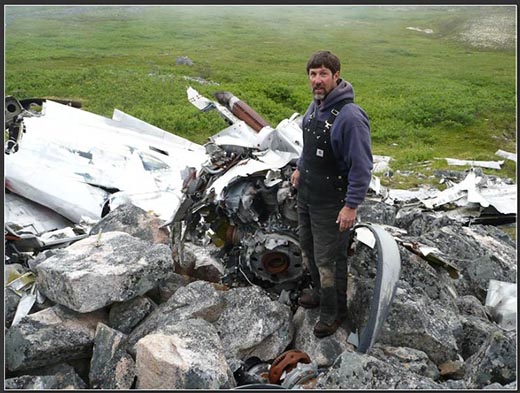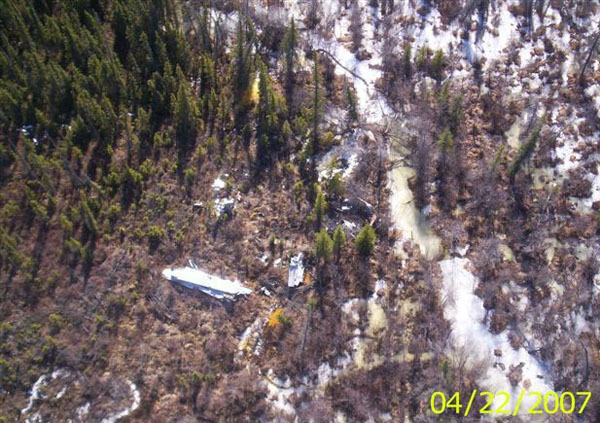|
Karl Hayes wrote me in January 2009 with a nice challenge...:
"On your website (the bookspage) you mention the book 'Triumph over Turbulence' by Jim Magoffin, which is about Interior Airways of Alaska, which was founded by Mr Magoffin. I read this book over the Christmas and it was a great read. He mentions two crashes which may be of interest for your 'Abandoned Aircraft of the North' department...
While N208M has been adressed in the item above, this next one is about C-46 N67982.
"Karl wrote: "He (Jim Magoffin) also mentions an incident involving a C-46 in the spring of 1968. (Photo further down).
The C-46 was landing on 'No Luck Lake', in the very remote western arctic region of Alaska. The lake was frozen at the time and the C-46 went through the ice!
There is a photograph of it in the book, sitting in the middle of the water after the ice had melted. He doesn't give a registration, but a bit of research shows this to be N67982, a C-46 of Interior. Again, the aircraft was just left there, so may well still be there..?"
Fortunately Francis Blake came to the rescue in may 2017! He contacted me with a splendid story and this unique photo of the unfortunate Curtiss C-46 N67982!

Curtiss C-46F N67982 (c/n 22584; ex/ USAF 44-78761)
lost in 'No Luck Lake', Alaska.
Before it went to Interior Airways it was acquired by Flying Tigers (and reg'd N67982) from the military.
I have not been able to find an occurrence report, perhaps this 1968 incident is buried in some paper files somewhere.
Francis wrote me: "Saw the blurb on the 'C-46 N67982 in No Luck Lake' (with a request for photos).
I have this close aerial photo of it sitting in the water, as described!
I took it in July 1972 while I was part of a geological field crew. We were tent camped at nearby Driftwood; our field transportation was a Bell Jet Ranger. Our cargo carriers were ex-C-46's and ex-C-47's."
Francis continued: "This particular C-46 (an -F model, #22584, 44-78761) stayed in the lake for decades. It landed on ice in June 1968 and broke through.
Interior Airways intended to rescue it, but never did.
1990's satellite photos showed it broken into two major sections and had moved to a different part of the lake from where I saw it. Winter storms?
But current sat pics do not show it so guess it has been removed and scrapped.
BTW: The original Indian name for the lake was 'Nullaq Lake', but you can easily see how it was corrupted to No Luck! I don't know if it became No Luck before or after the plane incident..?
Summer 1972 was my only time on the Slope. First at Sagwon, then Umiat, finally Driftwood."
|
I think the nickname found use after the incident as Google maps still goes by the native name 'Nullack Lake'.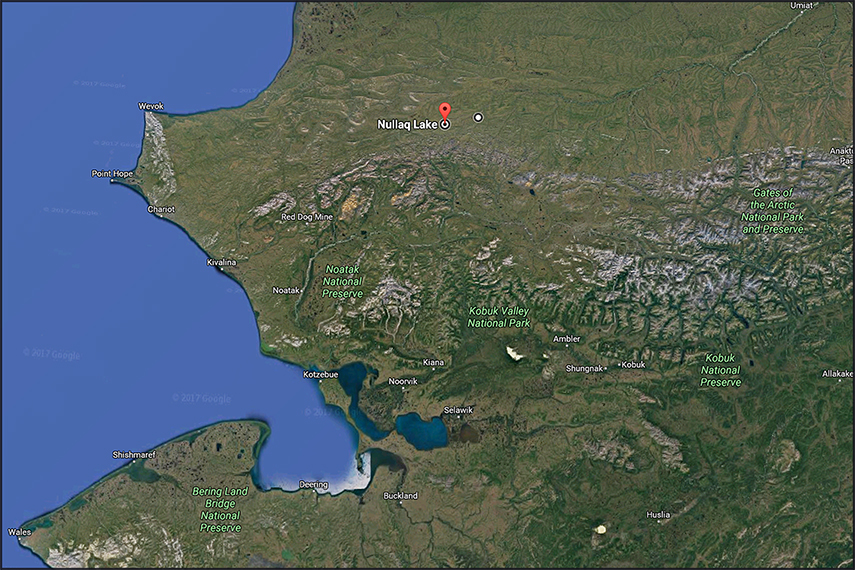
While Google Earth found the name Nullaq Lake it failed to zoom in on the spot, I marked it and named it again.
Zooming in with data from Google Maps I found GE did
have it named acordingly. The images do not show a plane.
Peter C. Hill did find it (Aug.2024), although on a low res: www.google.ca/maps/place/
In the book 'Triumph over Turbulence' (see my books page) I came across this photo:

So this statement obviously confirms it wasn't salvaged. Magoffin mentions 'hectic times', and I think he refers to
the construction of the
The Distant Early Warning Line, also known as the DEW Line or Early Warning Line. It was
a system of radar stations in the northern Arctic region of Canada, with additional stations along the north coast and Aleutian Islands of Alaska, in addition to the Faroe Islands, Greenland, and Iceland. It was set up to detect incoming bombers of the Soviet Union during the Cold War, and provide early warning of any sea-and-land invasion.
So maybe a half-hearted attempt was made to salvage it, or parts, hence the shack and barrels to fly it out..?
The barrels could have been flown in to drain fuel & oil, while working to salvage parts..?
It landed on ice which was going soft, the season may have worked against their timeline and Magoffin gave up on it.
In Sep.2022 I received an excellent update by Jacob C.!
'My brother is a bush pilot up in Alaska (www.aeroexpeditions.com). Summers he runs his own business out of Fairbanks and August/September he is out of Kotzebue.
The end of this July our family spent a week with him up there in the Noatak preserve. We were flying around, exploring one day in his 1976 Cessna 180J, when we realized we were close to a plane wreck (he has a gps app that has things like that on it).
We flew over to this lake and passed over the wreck several times; the plane had fallen apart but was there! A shack was built next to it, and barrels and debris had floated all over around the edges of the lake.
As a side note, about 5 minutes away, was a little bluff that also had several barrels strewn across the top of it and I wonder what from..?
We wrote down what we thought the tail number was (N67882) and vowed to look up what happened.
I finally got around to it managed to find your website as it mentions Nullaq Lake, and then I found the mention of this wreck!
It turns out we were off by only 1 number and it is N67982.
There were caribou on one side of the lake and a few bears a ways off on the other. We had 2 different maps, the one on the plane gps, and the one on his phone.
One had the lake labelled as Nollog lake, another as Nullaq lake.
I am excited to hear it was also called No luck lake, I am glad someone went in and fixed it on google maps.
I looked it up, and both google maps and apple maps mention "Nullaq lake", and the wreck can be seen in both; however my Google Maps had two black rectangles right over the plane, some image problem here is where the plane was (68.785679, -160.003403).
You can also see the shack back behind it, I wondered if the shack or barrels were from Francis Blake and his trip, but he said they were tent camping "at nearby driftwood". A G'maps search shows a driftwood creek not far from Nullaq lake, but not where we flew over those extra barrels (about here 68.783217, -159.925728)..
I am so happy I found your website! If you have any insights into the shack or plethora of barrels that would be nice!'
Jacob C. [27Sep2022]
|
Images by Jacob C, taken over Nullaq Lake on 28July2022
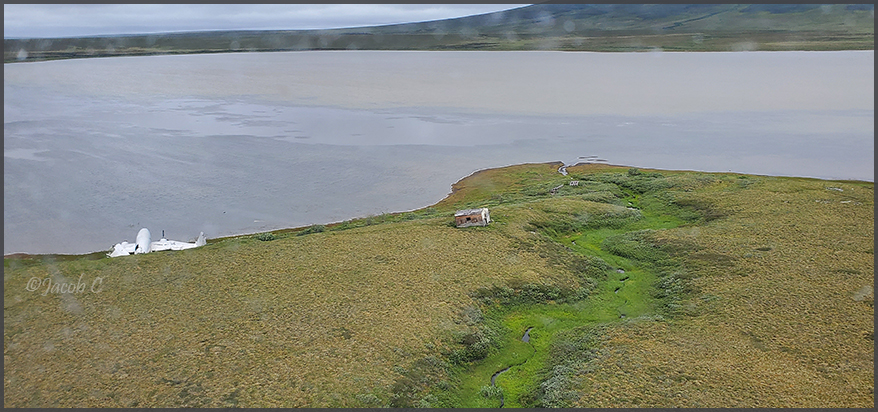

The shack may have served as temporary accommodation during an initial salvage attempt.
Or perhaps it was (is?) used
for hunters and/or people sport fishing..? Caribou and bears were sighted by Jacob C.

The barrels were probably washed ashore or otherwise dispersed by stormy weather.

Cropped

Screendump from a short video of the flypast
The many barrels may have been flown in to salvage the fuel and/or oil..?
At that attempt it sat further away from the shore, half submerged through the ice.
Storms, over decades, must have
damaged it and thus ended on shore which has withdrawn.
There seems to be a path leading to the wingtip, maybe used when on the left it was marshy grounds.
|




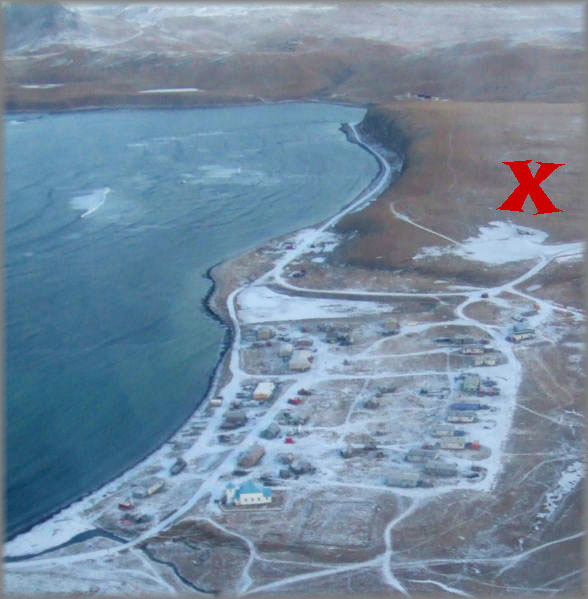
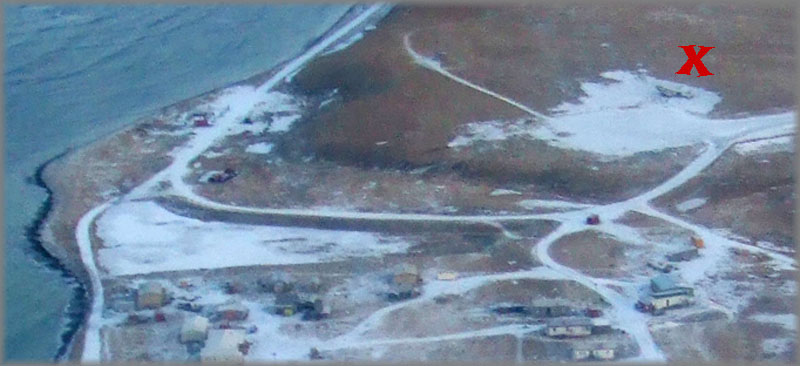





 Jan Fr. Mack made me notice this WW2 B-24 bomber, the wreckage surviving at Atka Island (Aleuts), Alaska.
Jan Fr. Mack made me notice this WW2 B-24 bomber, the wreckage surviving at Atka Island (Aleuts), Alaska. 
